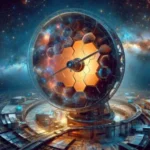The cosmos has long captivated the human imagination, from ancient stargazers tracing constellations to modern scientists unraveling the mysteries of distant galaxies.
At the heart of this celestial exploration lies the telescope, a remarkable instrument that has revolutionized our understanding of the universe. These powerful devices, whether perched atop mountain observatories or nestled in space, serve as our eyes to the cosmos, allowing us to peer deep into the fabric of space and time. In this blog post, we will embark on a journey to unveil the universe, exploring the intricate mechanics of how telescopes function and the remarkable discoveries they have facilitated. From the first refracting telescopes that sparked the scientific revolution to the sophisticated space-based observatories capturing breathtaking images of the universe, join us as we delve into the fascinating world of telescopes and their pivotal role in expanding our cosmic horizons.
1. Introduction to Telescopes and Their Importance in Astronomy

Telescopes have long been the gateway to the cosmos, transforming our understanding of the universe and our place within it. Since their invention in the early 17th century, these remarkable instruments have enabled astronomers to peer beyond the veil of our atmosphere, revealing celestial wonders that were once hidden to the naked eye. From the distant twinkle of stars to the swirling arms of galaxies, telescopes have not only expanded our cosmic horizons but have also sparked our deepest curiosity about the universe’s mysteries.
The importance of telescopes in astronomy cannot be overstated. They serve as the primary tool for observing and studying celestial objects, allowing scientists to gather crucial data about their composition, behavior, and evolution. Each type of telescope—whether optical, radio, or space-based—offers its own unique vantage point, enabling astronomers to decode the complex language of the universe. For instance, optical telescopes capture visible light, providing stunning images of planets, stars, and galaxies. Meanwhile, radio telescopes detect radio waves emitted by celestial bodies, revealing phenomena such as pulsars and quasars that would remain undetected through traditional means.
Moreover, telescopes have played a pivotal role in major astronomical breakthroughs, from the discovery of the moons of Jupiter by Galileo to the recent observations of exoplanets in distant solar systems. They have helped us chart the evolution of stars, understand the formation of galaxies, and even glimpse the remnants of the Big Bang itself. As technology advances, so too does our ability to explore the universe, with next-generation telescopes promising to unveil even more secrets of the cosmos.
In this blog post, we will delve deeper into the fascinating world of telescopes, exploring how they work, the different types available, and their impact on our quest for knowledge about the universe. Join us as we embark on a journey through the stars, illuminating the vital role telescopes play in expanding our understanding of the cosmos.
2. The History of Telescopes: From Galileo to Modern Innovations
The history of telescopes is a fascinating journey that stretches back over four centuries, beginning with the groundbreaking work of Galileo Galilei in the early 17th century. When Galileo first pointed his rudimentary telescope toward the skies in 1609, he opened a new window to the cosmos that would forever change our understanding of the universe. With his simple tube, he observed Jupiter’s moons, the intricate phases of Venus, and the rugged surface of the Moon, revealing celestial bodies in unprecedented detail. Galileo’s discoveries were not just scientific milestones; they challenged the prevailing geocentric worldview and laid the groundwork for modern astronomy.
As the centuries progressed, telescope technology advanced in leaps and bounds. The invention of the refracting telescope, which utilized lenses to gather and focus light, allowed astronomers to observe distant stars and galaxies with greater clarity. By the 18th century, figures like Sir Isaac Newton revolutionized telescope design with the introduction of the reflecting telescope, which used mirrors instead of lenses to eliminate chromatic aberration and improve image quality. Newton’s design marked a significant turning point, enabling astronomers to push the boundaries of exploration even further.
The 19th century brought about even more innovations, such as the development of larger and more powerful telescopes, including the Great Refractor at the Yerkes Observatory and the Hale Telescope at Mount Palomar. These colossal instruments allowed astronomers to capture images of celestial phenomena that were previously invisible to the naked eye. The advent of photography in the late 1800s added another dimension to astronomical observations, enabling scientists to document and analyze the universe in ways that had not been possible before.
In recent decades, the evolution of telescopes has accelerated with the advent of digital technology and advanced optics. Space-based telescopes, like the Hubble Space Telescope, have revolutionized our understanding of the universe by providing unprecedented views free from earth‘s atmospheric distortion. These modern marvels can capture stunning images of distant galaxies, nebulae, and exoplanets, expanding our cosmic horizons and deepening our comprehension of the universe’s vastness.
Today, researchers continue to innovate, developing next-generation telescopes that promise to unveil even more secrets of the cosmos. With projects like the James Webb Space Telescope, which aims to peer further back in time to the formation of the first stars and galaxies, the journey of telescopes from Galileo’s first observations to the cutting-edge technologies of today represents a remarkable odyssey of human curiosity and ingenuity. This rich history not only highlights our relentless pursuit of knowledge but also sets the stage for the exciting discoveries that lie ahead in our exploration of the universe.
3. Understanding Light: The Foundation of Telescope Functionality

To truly appreciate how telescopes work, one must first grasp the fundamental role of light in our universe. Light, the invisible thread that connects us to distant celestial bodies, is both a source of information and the medium through which we perceive the cosmos. When we gaze up at the night sky, we’re witnessing a tapestry woven from countless photons, each carrying unique stories from the stars, planets, and galaxies scattered across the vastness of space.
At its core, the functionality of a telescope hinges on its ability to collect and manipulate light. Telescopes operate on the principle of gathering light from a distant source, such as a star or galaxy, and focusing it to create a clear and magnified image. This is done using lenses or mirrors, depending on the type of telescope. In refracting telescopes, a series of carefully shaped lenses refract, or bend, light to converge at a focal point, producing an image that can be magnified for closer inspection. On the other hand, reflecting telescopes employ mirrors to collect light, allowing for larger apertures that capture more photons, resulting in brighter and more detailed images.
Understanding the behavior of light is crucial for astronomers. Light travels in waves and can be described in terms of wavelength and frequency, which correspond to different colors in the visible spectrum. However, light does not only reveal colors we can see; it also includes infrared, ultraviolet, and even X-ray wavelengths. Telescopes equipped with specialized instruments can detect these invisible wavelengths, unveiling phenomena beyond human perception, such as the heat emitted by distant stars or the composition of exoplanet atmospheres.
Moreover, the phenomenon of light pollution, caused by artificial lighting in urban areas, presents a significant challenge for astronomers. It obscures our view of the night sky, making it imperative for both amateur and professional astronomers to seek out darker locations to observe celestial wonders. This is why observatories are often positioned in remote areas, where the air is clearer and the night sky remains untainted by the glow of city lights.
In essence, understanding light is not just a scientific endeavor; it is the very foundation of our exploration of the universe. By harnessing its properties, telescopes serve as our windows to the cosmos, allowing us to unravel the mysteries of the universe and deepen our connection to the stars that have captivated humanity for millennia. As we continue to refine our telescopic technology and expand our understanding of light, we unlock the potential to explore further into the depths of space, revealing the secrets that lie beyond our terrestrial home.
4. Types of Telescopes: Refractors vs. Reflectors vs. Catadioptrics
When it comes to exploring the cosmos, the type of telescope you choose can significantly influence your astronomical experience. The three primary types—refractors, reflectors, and catadioptrics—each have unique designs and advantages that cater to different preferences and purposes.
**Refractors** are perhaps the most traditional type of telescope, using lenses to gather and focus light. With their sleek, elongated tubes and polished glass optics, refractors are known for producing sharp, high-contrast images, making them ideal for planetary and lunar observations. The simplicity of their design means less maintenance, and they often require no alignment, allowing for quick setup. However, larger refractors can become quite heavy and expensive due to the cost of high-quality glass.
**Reflectors**, on the other hand, utilize mirrors to collect and focus light, offering a different set of benefits. Invented by Sir Isaac Newton, the reflector telescope has a more compact design, allowing for larger apertures without the weight and expense associated with large lenses. This makes them excellent for deep-sky observations, such as galaxies and nebulae, where light-gathering ability is crucial. While reflectors can provide stunning views of faint celestial objects, they may require more frequent maintenance, as mirrors can accumulate dust and need periodic collimation to ensure optimal performance.
Finally, we have **catadioptrics**, which blend both lenses and mirrors to harness the best of both worlds. These hybrid telescopes are known for their versatility and portability, making them popular among amateur astronomers who seek a balance between performance and convenience. Catadioptrics, like the Schmidt-Cassegrain and Maksutov-Cassegrain designs, offer a compact form factor while delivering high-quality images, making them suitable for both planetary viewing and deep-sky exploration. Their closed tube design also minimizes dust accumulation, reducing maintenance needs.
By understanding the differences among these telescope types, stargazers can make informed choices that align with their interests and observing goals. Whether you prefer the classic appeal of a refractor, the robust capabilities of a reflector, or the compact convenience of a catadioptric, each telescope opens a unique window into the vastness of space, allowing us to unveil the universe one celestial body at a time.
5. How Telescopes Gather and Focus Light

At the heart of every telescope’s ability to unveil the mysteries of the cosmos lies its fundamental task: gathering and focusing light. This intricate process is what allows us to peer into the depths of space and explore celestial wonders that are otherwise invisible to the naked eye.
Telescopes operate on the principle that light, whether it comes from distant stars, planets, or galaxies, can be captured and manipulated. The larger the telescope’s aperture—the diameter of its main lens or mirror—the more light it can collect, allowing for clearer and more detailed images. For instance, a modest amateur telescope with a 4-inch aperture can reveal craters on the Moon, while a powerful observatory telescope with a 10-meter mirror can uncover the faint glow of distant galaxies billions of light-years away.
Once the light is gathered, it must be focused to form a coherent image. In refracting telescopes, this is achieved using lenses. The primary lens, known as the objective lens, bends light rays to converge at a focal point, creating a magnified image of the celestial object. In contrast, reflecting telescopes utilize mirrors to achieve the same goal. A primary mirror collects incoming light and reflects it to a focal point, where it can then be viewed through an eyepiece or captured by a camera.
The precision of this gathering and focusing process is paramount. Any distortion in the lenses or mirrors can lead to blurred images, obscuring the details of the universe that astronomers are eager to study. This is why high-quality glass and meticulous craftsmanship are essential components in the making of telescopes, enabling them to deliver crisp, clear views of the cosmos.
Moreover, modern advancements have introduced adaptive optics technology, allowing telescopes to compensate for atmospheric disturbances caused by Earth’s turbulent atmosphere. This ensures that the images captured from our ground-based observatories are as sharp as those taken from space, where light can be gathered without interference.
In essence, the way telescopes gather and focus light is a remarkable blend of physics and engineering. It transforms faint starlight into vivid images, expanding our understanding of the universe and inviting us to explore the infinite wonders that lie beyond our planet. Through this intricate dance of light, telescopes not only illuminate the night sky but also spark our curiosity to learn more about the vastness that surrounds us.
6. The Role of Aperture in Telescope Performance
When it comes to telescopes, the aperture is often considered the heart of the instrument, playing a crucial role in determining its overall performance. The term “aperture” refers to the diameter of the telescope’s main lens or mirror, and its size directly influences the amount of light that the telescope can collect.
Imagine trying to fill a large container with water using a tiny cup versus a wide bucket. The bucket, with its larger opening, allows for a much greater volume to flow in at once—similarly, a telescope with a larger aperture can gather far more light than one with a smaller opening. This enhanced light-gathering ability results in brighter and clearer images of celestial objects, enabling astronomers to observe fainter stars, distant galaxies, and intricate details within nebulae that would otherwise remain hidden to the naked eye.
Additionally, the aperture affects the resolving power of a telescope—the ability to distinguish between two close objects in the sky. A larger aperture means better resolution, allowing astronomers to see fine details in planetary features or the structure of double stars. Conversely, a telescope with a smaller aperture may struggle to resolve these details, leading to blurry or indistinct images.
However, it’s not just about size; the quality of the optics and the design of the telescope also plays a significant role in how effectively an aperture can perform. High-quality lenses and mirrors made from superior materials can minimize optical aberrations, ensuring that the light collected is as clear and sharp as possible.
In essence, when selecting a telescope, understanding the relationship between aperture and performance is vital. Whether you’re a novice stargazer or an experienced astronomer, investing in a telescope with an appropriate aperture can dramatically enhance your ability to explore the wonders of the universe, bringing the cosmos closer than ever before.
7. Magnification and Resolution: What They Mean for Observations

Magnification and resolution are two fundamental concepts that play pivotal roles in the quality of astronomical observations, each contributing uniquely to how we perceive celestial bodies. While magnification refers to the power of a telescope to enlarge an object, resolution denotes the clarity and detail of that image.
To understand these concepts better, imagine peering through a pair of binoculars at a distant mountain. The higher the magnification, the larger the mountain appears in your view. However, if the binoculars lack sufficient resolution, the image may appear blurry or indistinct, obscuring the intricate details of the mountain’s peaks and valleys. In the realm of telescopes, this analogy holds true, yet the stakes are even higher. Astronomers are not merely observing mountains; they are studying galaxies, nebulae, and the intricate dance of distant stars.
Magnification is achieved through a combination of the telescope’s design and the eyepiece used. A telescope with a longer focal length can magnify objects more than one with a shorter focal length. However, excessive magnification can lead to diminishing returns; an image may become so enlarged that it loses clarity.
This is where resolution comes into play. It is determined by the telescope’s aperture—the diameter of its primary lens or mirror. A larger aperture allows more light to enter, resulting in a clearer and more detailed image. This is why professional observatories utilize massive telescopes, often several meters in diameter, to capture the faint light from distant galaxies.
In essence, the balance between magnification and resolution is crucial for successful astronomical observations. A telescope that offers high magnification but lacks adequate resolution can lead to frustrating viewing experiences, as details become lost in a haze of indistinct colors. Conversely, a telescope with excellent resolution but low magnification might reveal stunning details of nearby planets while leaving the more distant galaxies frustratingly small.
As we continue to unveil the universe, understanding the relationship between magnification and resolution allows both amateur stargazers and seasoned astronomers to choose the right equipment for their cosmic explorations. This knowledge equips them to make informed decisions, ultimately enriching their experience as they delve deeper into the wonders of the night sky. With each observation, we take another step toward understanding our place in the vast cosmos, one clear image at a time.
8. Advanced Telescope Technologies: Adaptive Optics and CCD Sensors
In the quest to unveil the mysteries of the universe, advanced telescope technologies have revolutionized our ability to observe celestial phenomena with unprecedented clarity. Among these technologies, adaptive optics and charge-coupled device (CCD) sensors stand out as game-changers in modern astronomy.
**Adaptive Optics: Overcoming the Earth’s Atmosphere**
One of the greatest challenges in ground-based astronomy is the distortion caused by the Earth’s atmosphere. As light from distant stars and galaxies passes through layers of turbulent air, it becomes blurred, leading to distorted images that can frustrate even the most seasoned astronomers. Enter adaptive optics—a technology designed to correct these distortions in real-time.
Adaptive optics systems employ a series of flexible mirrors that adjust their shape thousands of times per second. These mirrors react to changes in atmospheric conditions, effectively counteracting the blurring effects of the atmosphere. By using a reference star or laser guide star, astronomers can measure distortions and tweak the mirrors accordingly, resulting in crisp, high-resolution images that reveal details previously hidden from view. This technology has been instrumental in advancing our understanding of phenomena such as the formation of stars and the dynamics of distant galaxies.
**CCD Sensors: Capturing Cosmic Wonders**
While adaptive optics enhances image quality, CCD sensors play a crucial role in capturing those images with remarkable precision. Unlike traditional photographic film, CCD sensors convert incoming light into electrical signals, which are then digitized for analysis. This digital imaging technology offers several advantages, including increased sensitivity to low light levels and the ability to capture images with a wide dynamic range.
CCD sensors are particularly adept at capturing transient astronomical events, such as supernovae or the fleeting passage of comets. Their high sensitivity allows astronomers to observe faint objects that would otherwise go unnoticed, expanding our cosmic horizons. Moreover, the digital nature of CCD sensors facilitates quick data processing and storage, enabling researchers to analyze vast amounts of information and share their findings with the scientific community almost instantaneously.
By harnessing the power of adaptive optics and CCD sensors, astronomers are not only enhancing our ability to observe the night sky but also uncovering new insights into the fundamental workings of the universe. These advanced technologies continue to push the boundaries of what we can see, helping us piece together the grand tapestry of cosmic history and our place within it. As we look to the future, one thing is certain: the universe is vast and full of wonders, and with these innovative tools, we are just beginning to scratch the surface of what lies beyond our home planet.
9. The Importance of Location: Observatories and the Night Sky
The location of an observatory plays a critical role in the quality of astronomical observations, influencing everything from the clarity of the night sky to the accessibility of celestial phenomena. An ideal observatory site is characterized by several key factors, including altitude, atmospheric conditions, and light pollution levels. High-altitude locations, such as mountaintops, offer a significant advantage by reducing the amount of atmosphere that light must traverse, leading to sharper images and enhanced visibility of faint objects.
Moreover, clear skies are paramount for effective stargazing. Observatories are often situated in remote areas, far from the glare of city lights that can obscure the beauty of the cosmos. Light pollution not only diminishes the visibility of celestial bodies but also alters the natural darkness that astronomers rely on to study the universe. This is why many observatories are found in national parks or desert regions, where the night sky remains untainted by human interference.
Additionally, atmospheric conditions are crucial. Observatories located in regions with stable air masses experience less turbulence, resulting in steadier images. This is why many of the world’s leading observatories are found in places like Mauna Kea in Hawaii and the Atacama Desert in Chile, where the unique climatic conditions foster optimal stargazing.
Ultimately, the combination of altitude, minimal light pollution, and favorable atmospheric conditions creates a sanctuary for astronomers—an environment where the wonders of the universe can be explored in their full glory. Observatories, by virtue of their strategic locations, not only enhance our understanding of the cosmos but also inspire a sense of awe and curiosity about the universe that surrounds us.
10. Telescopes in Space: Hubble and Beyond
When we think of telescopes, our minds often conjure images of those fixed to observatory rooftops or perched on backyard decks, peering into the vast expanse of the night sky. However, the most astonishing views of our universe come from those that break free of Earth’s atmospheric constraints—space telescopes. Among these, the Hubble Space Telescope stands as a monumental achievement in astronomical observation, having transformed our understanding of the cosmos since its launch in 1990.
Hubble orbits Earth at an altitude of approximately 547 kilometers (about 340 miles), where it escapes the blurring effects of the atmosphere that plague ground-based telescopes. This unique vantage point allows Hubble to capture images with unprecedented clarity, revealing the intricate details of distant galaxies, nebulae, and celestial phenomena. Its powerful instruments detect a wide range of wavelengths, from ultraviolet to visible light, providing astronomers with a comprehensive view of the universe.
Beyond Hubble, several space telescopes have either been launched or are in development, each designed to explore different facets of our universe. The James Webb Space Telescope (JWST), which launched in December 2021, promises to delve deeper into the infrared spectrum, enabling scientists to observe the formation of stars and galaxies in the early universe. The intricacies of JWST’s mirror, composed of 18 hexagonal segments, and its advanced instruments set the stage for groundbreaking discoveries that could reshape our understanding of cosmic evolution.
Then there’s the European Space Agency’s Gaia mission, which meticulously maps the Milky Way by measuring the positions and movements of over a billion stars. This ambitious project not only enhances our understanding of galactic structure but also aids in the search for exoplanets by identifying gravitational influences on distant stars.
As technology advances, the potential for future space telescopes becomes even more exciting. Concepts for missions like the Habitable Exoplanet Observatory (HabEx) and the Lynx X-ray Observatory are already in discussion, with ambitious goals of identifying habitable worlds and studying the universe’s most energetic phenomena.
In summary, space telescopes like Hubble and its successors are more than just instruments; they are our gateways to the universe. By operating beyond the confines of Earth’s atmosphere, they provide us with clearer, more detailed views of the cosmos, allowing us to unlock its deepest mysteries and expand our cosmic horizons in ways we never thought possible. As we continue to develop and deploy these remarkable observatories, the universe’s secrets will gradually unfold, revealing the wonders that lie beyond our own planet.
11. Citizen Science: How Amateur Astronomers Use Telescopes
Citizen science has become a vibrant and integral part of modern astronomy, allowing amateur astronomers to contribute to our understanding of the universe in meaningful ways. With the advent of affordable telescopes and advanced imaging technology, enthusiasts from all walks of life are stepping outside and pointing their instruments skyward, bridging the gap between professional research and personal exploration.
Amateur astronomers often begin their journeys with a simple telescope, eager to observe celestial wonders like the craters of the Moon, the rings of Saturn, or the distant glow of nebulae. However, many take it a step further by participating in collaborative projects that require careful observation and data collection. Through platforms like Galaxy Zoo or the American Association of Variable Star Observers (AAVSO), these stargazers can analyze and classify astronomical phenomena, contributing valuable insights to ongoing research.
One notable example is the discovery of new exoplanets and variable stars. Armed with their telescopes and a passion for discovery, amateur astronomers can detect subtle changes in the brightness of stars, signaling potential planetary transits or stellar variations. This grassroots involvement not only enriches scientific knowledge but also fosters a sense of community among stargazers, as they share their findings, tips, and experiences online.
Moreover, social media and dedicated forums have transformed the way amateur astronomers connect and collaborate. As they share images and data, they also engage in discussions about the latest celestial events, such as meteor showers or eclipses, encouraging others to join in on the excitement. This collaborative spirit amplifies the reach of astronomical discoveries and inspires new generations of skywatchers.
In this age of technology, citizen scientists wield the power of telescopes not just for personal enjoyment, but as a means to contribute to the vast tapestry of cosmic knowledge. By participating in this collective effort, they help illuminate the mysteries of the universe, proving that you don’t need a Ph.D. to make a significant impact in the field of astronomy. As the night sky continues to captivate our imaginations, amateur astronomers stand ready, telescope in hand, to unveil its secrets one observation at a time.
12. The Future of Telescope Technology: Upcoming Innovations
As we stand on the brink of a new era in astronomical exploration, the future of telescope technology promises to be nothing short of revolutionary. Upcoming innovations are set to expand our cosmic horizons in ways we have only begun to imagine.
One of the most exciting advancements is the development of adaptive optics systems, which aim to correct distortions caused by Earth’s atmosphere in real-time. This technology allows ground-based telescopes to achieve clarity previously reserved for their space-based counterparts. As these systems become more sophisticated, astronomers will gain unprecedented detail in their observations, revealing the intricate structures of distant galaxies and the elusive atmospheres of exoplanets.
Another groundbreaking innovation is the rise of large-scale telescope arrays, such as the upcoming Extremely Large Telescope (ELT) and the Thirty Meter Telescope (TMT). These colossal instruments will boast mirrors that are significantly larger than anything currently in operation, providing unparalleled light-gathering power. With these telescopes, astronomers will be able to not only peer deeper into the universe but also conduct detailed studies of celestial phenomena, from the formation of stars to the behavior of black holes.
Moreover, advancements in infrared and radio telescope technology are opening new windows to the cosmos. The James Webb Space Telescope (JWST), set to launch soon, will delve into the infrared spectrum, revealing hidden details about the early universe and the formation of stars and galaxies. Meanwhile, radio telescopes are evolving with the Square Kilometre Array (SKA), which promises to be the most sensitive radio telescope ever built, enabling us to explore the mysteries of cosmic magnetism, dark matter, and the very nature of the universe itself.
As we look ahead, the integration of artificial intelligence (AI) and machine learning into telescope operations will further enhance our observational capabilities. These technologies will streamline data analysis, enabling astronomers to sift through vast amounts of information and identify patterns and anomalies that would otherwise go unnoticed.
In summary, the future of telescope technology is a tapestry of innovation, collaboration, and discovery. With each new advancement, we inch closer to understanding the universe’s deepest secrets, unveiling the rich tapestry of cosmic history that has shaped our existence. As these technologies come to fruition, we will not only expand our knowledge of the universe but also inspire future generations to look up and explore the vastness of space.
13. Telescopes and Their Role in Discovering Exoplanets and Galaxies
Telescopes have revolutionized our understanding of the cosmos, acting as our eyes to the universe beyond our own planet. With their advanced technology, telescopes play a pivotal role in the discovery of exoplanets and galaxies, opening up new frontiers in our quest to understand the universe’s mysteries.
When we look at distant stars, we are actually peering into the past, as the light from those celestial bodies takes years or even centuries to reach us. Telescopes amplify this light, allowing astronomers to observe and analyze objects that are light-years away. More sophisticated models, such as space telescopes like the Hubble and the more recent James Webb Space Telescope, operate beyond the Earth’s atmosphere, which can distort and block certain wavelengths of light. By capturing clearer images, these instruments provide invaluable insights into the formation and evolution of galaxies, star systems, and the potential for life beyond our solar system.
One of the most exciting applications of telescopes is the detection of exoplanets—planets that orbit stars outside our solar system. Using techniques such as the transit method, telescopes can observe the slight dimming of a star’s brightness when a planet passes in front of it. This method has led to the discovery of thousands of exoplanets, some of which exist in the “habitable zone” where conditions could support life.
Furthermore, telescopes also employ spectroscopy to analyze the light from distant objects. By studying the spectrum of light emitted or absorbed by a star or planet, astronomers can glean information about its composition, temperature, and even potential atmospheres. This process not only aids in the identification of exoplanets but also enhances our understanding of the galaxies they inhabit.
As we continue to innovate and improve telescope technology, our ability to explore and understand the universe expands exponentially. With each new discovery, we draw closer to answering fundamental questions about our place in the cosmos, solidifying telescopes’ indispensable role in unveiling the universe’s vast tapestry. The next time you gaze up at the night sky, remember that each twinkling star is a potential gateway to new worlds waiting to be discovered.
14. Environmental Challenges: Light Pollution and its Impact on Astronomy
As we gaze into the vastness of the night sky, the brilliance of celestial bodies can often be obscured by a phenomenon known as light pollution. This pervasive environmental challenge has grown increasingly problematic in our modern world, where urbanization and artificial lighting have transformed the landscape of our nights. Light pollution refers to the excessive and misdirected artificial light produced by streetlights, buildings, and signage that bathes our cities in a glow, drowning out the subtle twinkle of stars and other astronomical wonders.
For astronomers, both amateur and professional, light pollution can severely limit observational capabilities. The once-clear canvas of the cosmos becomes muddied with a haze of artificial light, making it difficult to discern faint stars and distant galaxies. This interference not only diminishes the beauty of the night sky but also inhibits scientific research. Telescopes, which are designed to collect and magnify light from celestial objects, struggle to filter out the overwhelming brightness of city lights, leading to less accurate data and hindered discoveries.
The impact of light pollution extends beyond the realm of astronomy; it also affects wildlife, disrupts ecosystems, and can even impact human health by interfering with our circadian rhythms. In the field of astronomy, however, efforts are underway to mitigate these effects. Many observatories are relocating to darker, remote locations, away from urban centers. Additionally, astronomers are advocating for policies that promote better lighting practices, such as using downward-facing fixtures and minimizing unnecessary illumination.
As individuals, we can also play a role in combating light pollution by being mindful of our own lighting choices. By opting for dimmer, warmer lights, using motion sensors, and turning off lights when not needed, we can help preserve the beauty of the night sky for future generations. Every small step taken to reduce light pollution contributes to a clearer view of the universe, allowing telescopes to unlock the secrets of the cosmos and expand our understanding of the vastness beyond our planet. In doing so, we not only protect our astronomical heritage but also reconnect with the wonder of the stars that have inspired humanity for millennia.
15. Conclusion: The Ongoing Journey of Discovery through Telescopes
As we draw our exploration of telescopes to a close, it becomes clear that our understanding of the universe is still in its infancy. Telescopes, those magnificent instruments that have opened our eyes to the cosmos, are not merely tools; they are gateways to the unknown. From the early days of Galileo, peering through a rudimentary lens to observe the moons of Jupiter, to the sophisticated observatories of today, such as the Hubble Space Telescope, humanity’s quest to uncover the secrets of the universe has only intensified.
The journey of discovery through telescopes is ongoing and ever-evolving. Each new advancement in technology brings with it the potential for groundbreaking revelations about our cosmic environment. Imagine the excitement surrounding the upcoming James Webb Space Telescope, designed to peer deeper into the universe than ever before, potentially revealing the formation of stars, galaxies, and even the conditions for life on distant exoplanets. The possibilities are as vast as the universe itself.
Moreover, the accessibility of telescopes has democratized astronomy. With high-quality telescopes available at consumer-friendly prices, amateur astronomers are now contributing to our collective understanding of the cosmos. Citizen science initiatives enable enthusiasts to report their findings, contributing valuable data to the scientific community.
As we stand on the precipice of new discoveries, it is essential to embrace the spirit of curiosity and wonder that drives us to look up at the night sky. The universe is a tapestry of mysteries waiting to be unraveled, and telescopes are the threads that weave our understanding of its intricate design. So, whether you’re a seasoned astronomer or a curious newcomer, keep looking up—every gaze into the cosmos is a step further in our ongoing journey of discovery. The universe awaits, and with each observation, we inch closer to unveiling its many secrets.
As we conclude our exploration of how telescopes work to unveil the mysteries of the universe, we are reminded of the profound impact these remarkable instruments have on our understanding of the cosmos. From the intricate mechanics of lenses and mirrors to the groundbreaking discoveries that have reshaped our view of space, telescopes serve as our eyes into the vast unknown. They not only expand our cosmic horizons but also ignite our curiosity and inspire future generations of astronomers and dreamers. As you gaze at the stars, remember that each twinkle represents a story waiting to be told, and with every advancement in telescope technology, we are one step closer to uncovering the secrets of the universe. Thank you for joining us on this cosmic journey, and may your fascination with the night sky continue to grow!






